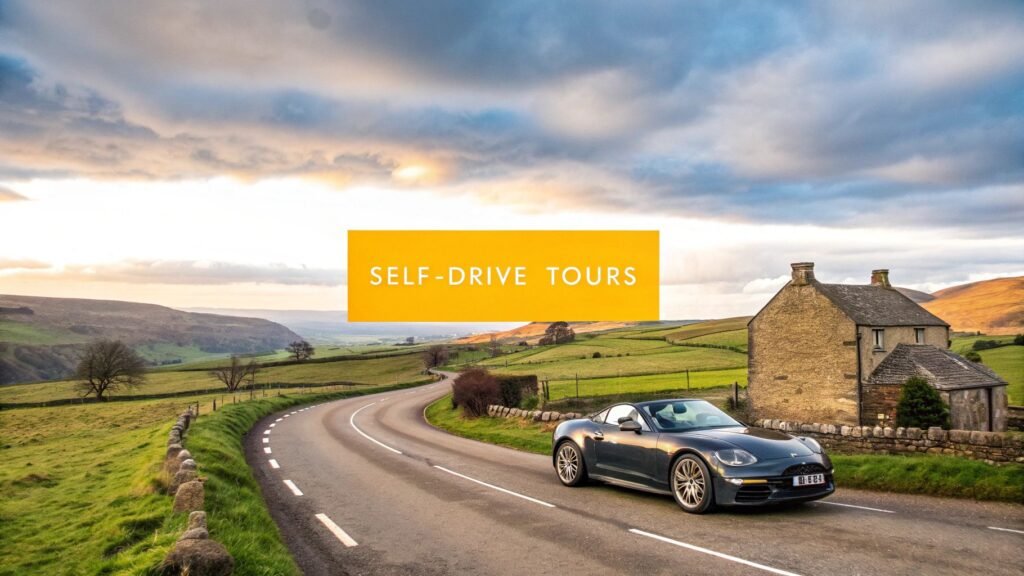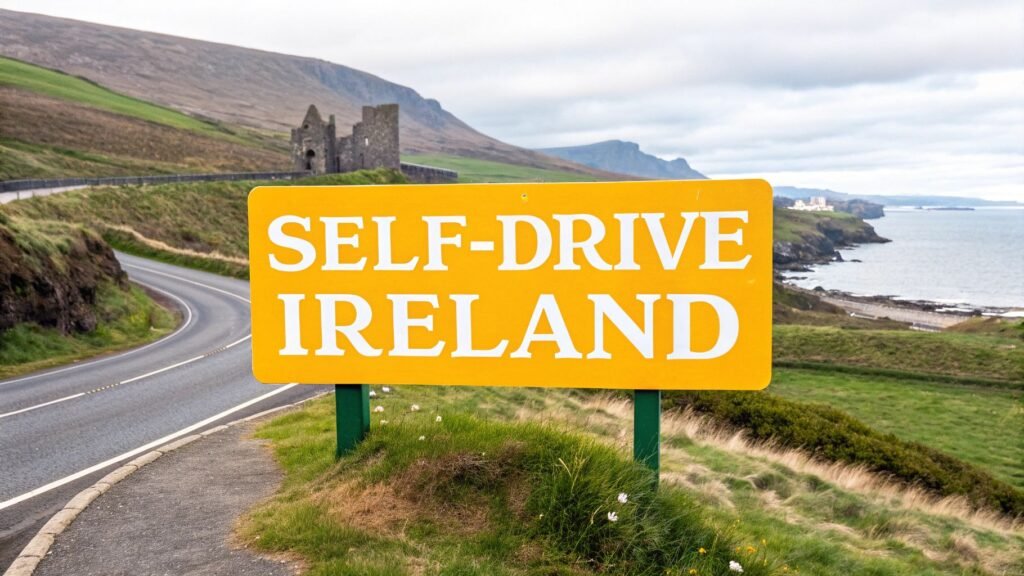Embarking on a multi-day self-drive tour offers unparalleled freedom to explore hidden gems and iconic landscapes at your own pace. The allure of the open road is undeniable, promising adventure, spontaneity, and the creation of lasting memories. However, a truly exceptional journey is built on a foundation of safety and preparation. Without it, unforeseen events, from minor vehicle issues and sudden weather changes to driver fatigue, can quickly turn an exciting expedition into a stressful ordeal.
This guide moves beyond generic suggestions to provide a comprehensive roundup of critical road trip safety tips. Our goal is to empower you with the knowledge needed for a secure and seamless adventure. We will delve into actionable strategies covering everything from in-depth pre-trip vehicle inspections and building a robust emergency kit to mastering defensive driving techniques and securing your vehicle against theft. By focusing on practical, implementation-focused advice, you can confidently handle whatever the road throws your way.
While our focus here is specifically on vehicle-based travel, it’s always wise to be prepared for broader security concerns on any vacation. For a wider perspective, you can review some general holiday safety advice to ensure all aspects of your trip are covered. By taking these proactive steps, you can shift your focus from worrying about what could go wrong to immersing yourself in the experience. Let’s ensure your next self-drive tour is memorable for all the right reasons.
1. Pre-Trip Vehicle Inspection
The single most effective measure for preventing on-road breakdowns and accidents is a thorough pre-trip vehicle inspection. This proactive check goes beyond a simple glance, involving a systematic review of your vehicle’s critical systems to identify and rectify potential failures before they escalate into dangerous situations miles from home. Think of it as a pre-flight check for your car; just as commercial trucking companies mandate daily inspections and NASCAR teams perform meticulous pre-race examinations, a comprehensive check is a cornerstone of any successful and safe road trip.
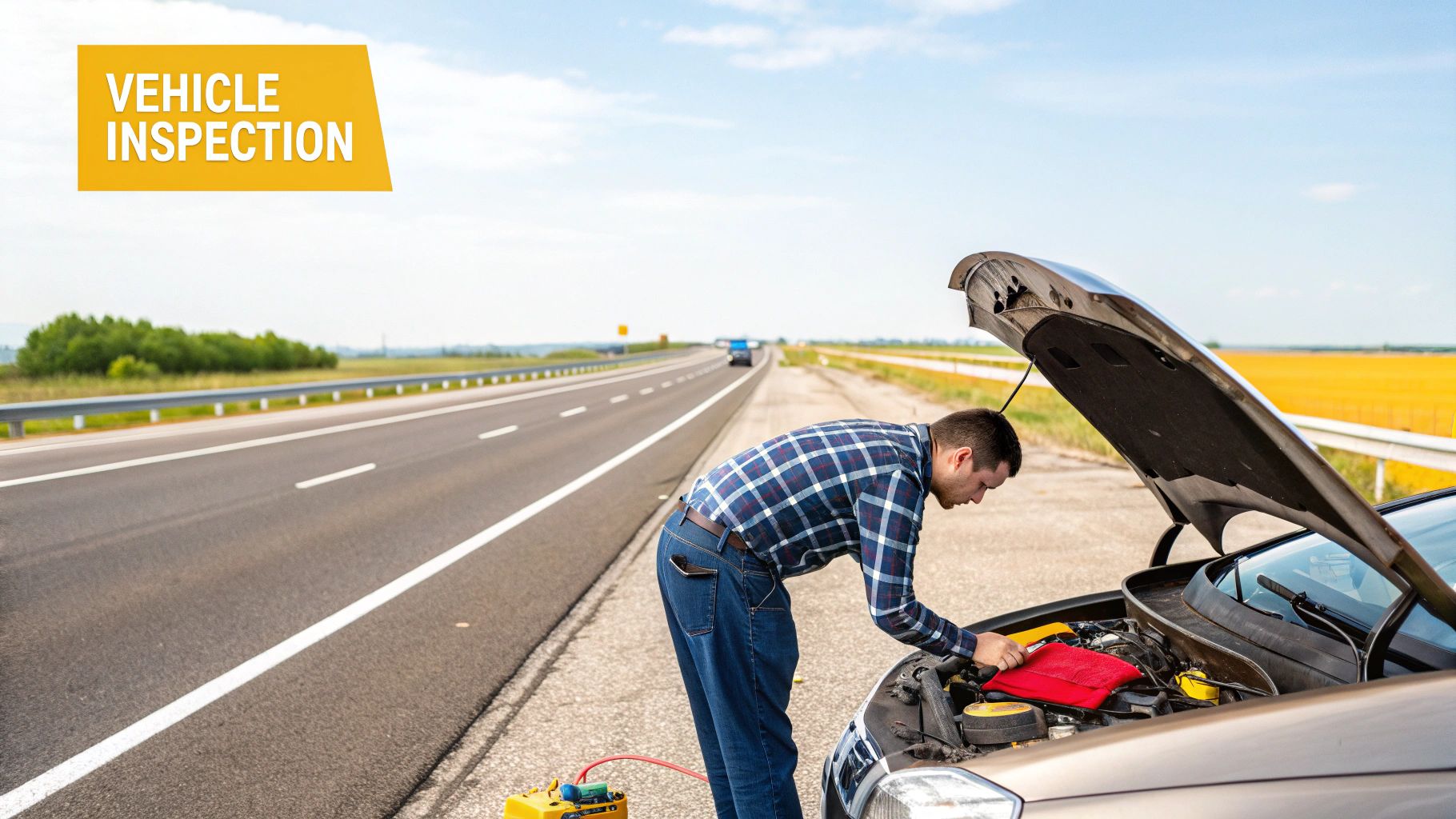
This step is non-negotiable, whether you’re driving a brand-new SUV or a trusted older sedan. The stresses of a long-distance journey, including prolonged high speeds, heavy loads, and varied climates, can expose underlying mechanical weaknesses. According to AAA, conducting these checks can significantly reduce the likelihood of a breakdown, ensuring your adventure isn’t derailed by a preventable issue.
Your Essential Inspection Checklist
For a truly effective check, follow a structured process. This ensures you don’t miss any critical components.
- Tires are Paramount: Check the pressure in all four tires (plus the spare) when they are cold, inflating them to the manufacturer’s recommended PSI found on the driver’s side doorjamb sticker. Use the “penny test” to check tread depth: insert a penny into the tread with Lincoln’s head upside down. If you can see all of his head, your tires are worn and need replacement.
- Fluids and Filters: Your vehicle’s lifeblood. Check engine oil, coolant, brake fluid, power steering fluid, and windshield washer fluid levels. If any are low, top them off. If the fluid appears dirty or gritty, especially engine oil or brake fluid, consider a professional service before you depart.
- Lights and Signals: Enlist a helper to confirm all exterior lights are functioning correctly. Test your headlights (both low and high beams), taillights, brake lights, and turn signals.
- Brakes and Battery: Listen for any squealing or grinding when you apply the brakes, a clear sign that they need professional attention. Visually inspect the battery terminals for any white, corrosive buildup and clean it off if necessary to ensure a solid connection.
For a visual guide on what to look for, this video provides an excellent walkthrough of a basic pre-trip check:
Completing this inspection a week before your trip gives you ample time to address any issues you discover without last-minute panic. It is one of the most vital road trip safety tips because it empowers you to take control of your vehicle’s reliability, turning a potential disaster into a minor, pre-trip repair.
2. Emergency Kit Preparation
While a pre-trip inspection mitigates the risk of a breakdown, it doesn’t eliminate it entirely. Assembling a comprehensive emergency kit is your next line of defence, providing the essential tools and supplies to manage unforeseen events. This kit is more than just a box of items; it’s a crucial safety net designed to help you handle anything from a minor mechanical issue to a medical situation or an extended delay caused by extreme weather or a major traffic incident. Organisations like the American Red Cross and FEMA champion this level of preparedness, understanding that self-sufficiency is key during the initial hours of any emergency.
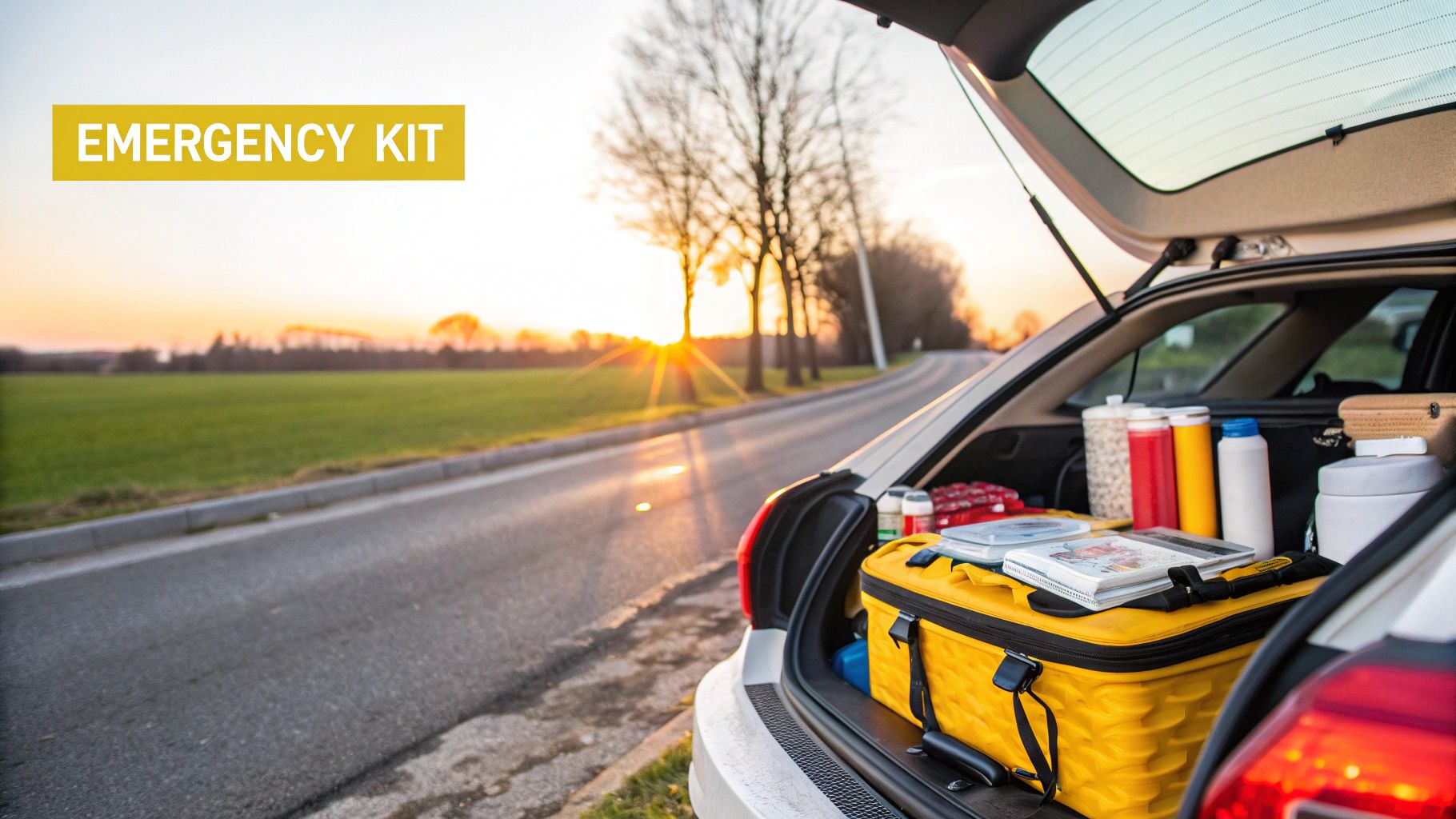
This preparation is vital regardless of your destination, whether you’re traversing remote desert highways or busy interstate corridors. A simple flat tire, a dead battery, or an unexpected road closure can quickly shift from a minor inconvenience to a serious safety concern if you are unprepared. Having a well-stocked kit ensures you can stay safe, warm, and hydrated while waiting for assistance or navigating the problem yourself, making it one of the most critical road trip safety tips you can follow.
Your Essential Kit Checklist
A truly effective emergency kit is organised into categories, ensuring you can quickly find what you need when stress levels are high.
- Vehicle Recovery and Repair: These are the tools to get you back on the road. Include a set of quality jumper cables, a portable tire inflator, a tire pressure gauge, and a basic toolkit with wrenches, pliers, and screwdrivers. Reflective triangles or road flares are non-negotiable for visibility and safety if you’re stopped on the shoulder.
- Personal Survival and First-Aid: This section covers human needs. Pack a well-stocked first-aid kit, non-perishable food (like energy bars and dried fruit), and at least one gallon of water per person per day, aiming for a 72-hour supply. Include warm blankets, a flashlight with extra batteries, and a multi-tool.
- Communication and Navigation: Technology can fail, so have backups. A portable power bank for your phone is essential. Also, keep a physical road map of the area you’re travelling through, along with a written list of emergency contacts, your auto insurance provider, and roadside assistance numbers.
- Seasonal and Regional Items: Tailor your kit to your journey. For winter travel, add an ice scraper, a small shovel, and cat litter or sand for traction. For trips through hot, arid regions, pack extra water and sun protection like hats and sunscreen.
Assembling this kit before you leave provides immense peace of mind. It transforms a potentially frightening roadside situation into a manageable event, empowering you to handle the unexpected with confidence and ensuring your adventure continues safely.
3. Route Planning and Navigation Backup
A well-planned route is the backbone of a safe and enjoyable journey, but relying solely on a single navigation tool is a significant risk. Effective route planning involves creating a primary itinerary while also preparing for the unexpected with backup navigation methods. This ensures that a dead phone battery, a spotty GPS signal in a remote area, or an unforeseen road closure doesn’t leave you lost and vulnerable. Just as emergency services maintain detailed area maps and professional delivery companies use sophisticated route optimisation, a multi-layered navigation strategy is a critical safety net for any road tripper.
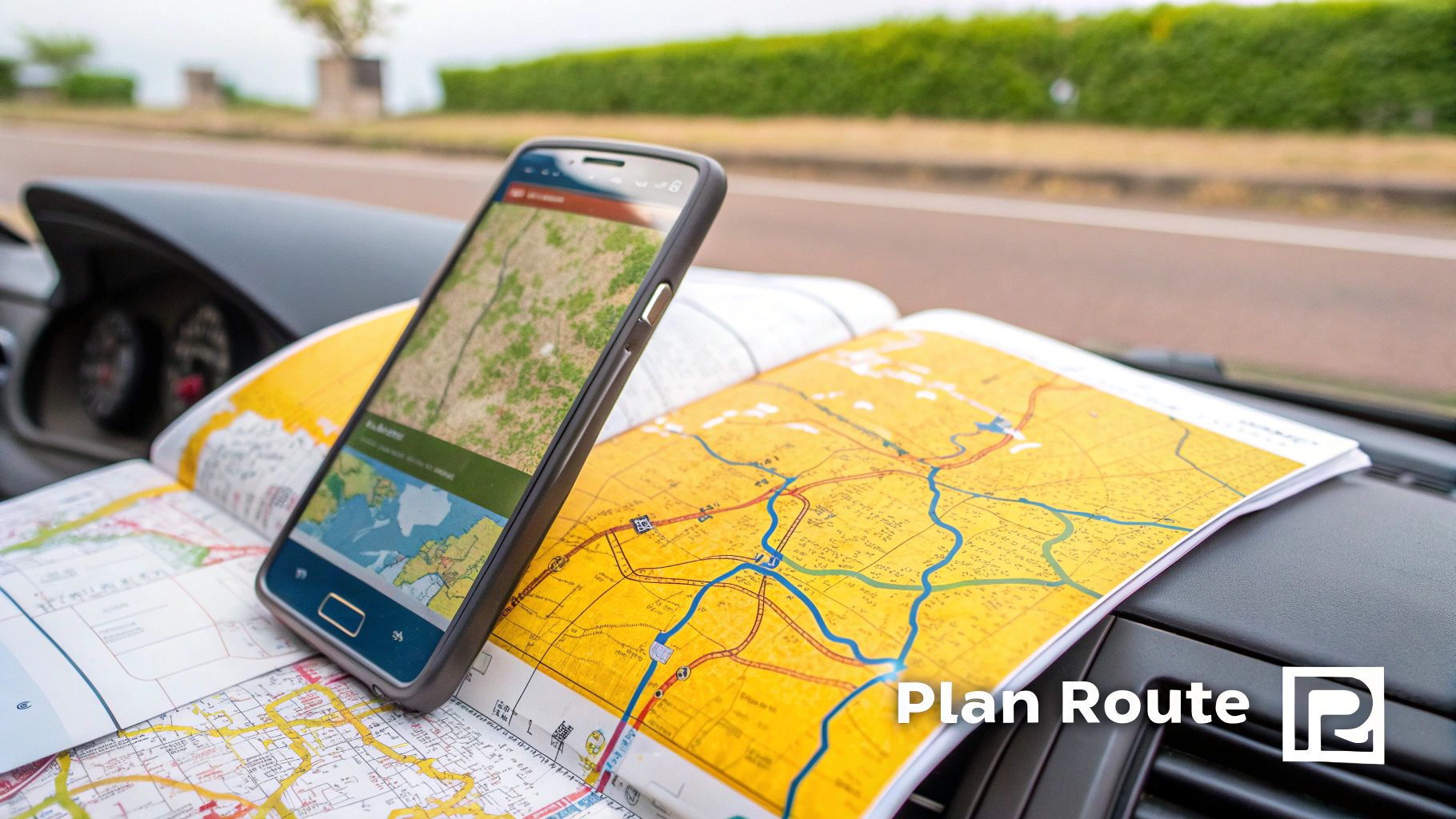
This preparation is vital because modern technology, while convenient, can be fragile. The long stretches of highway and remote landscapes often featured in self-drive tours can have inconsistent cellular service, rendering real-time apps like Waze or Google Maps useless. By having both digital and physical backups, you build resilience into your travel plan, allowing you to adapt to changing conditions with confidence instead of panic. This forward-thinking approach is one of the most important road trip safety tips you can implement.
Your Essential Navigation Strategy
To build a robust navigation plan, you need to think beyond simply plugging an address into your GPS. A comprehensive strategy covers technology, logistics, and communication.
- Go Offline and Analogue: Before you leave, use your preferred navigation app (Google Maps, Waze, etc.) to download the entire map area for your route for offline use. Critically, also purchase a recent, detailed paper road atlas or physical maps for your destination region. This analogue tool is your ultimate fail-safe; it requires no power and works everywhere.
- Scout Your Route in Advance: Pre-plan your journey by identifying key waypoints like gas stations, designated rest stops, and potential overnight lodging. Note their locations on both your digital and physical maps. Also, check for long-term construction projects or seasonal road closures on state Department of Transportation websites.
- Share Your Itinerary: Always give a copy of your detailed itinerary, including planned routes and estimated arrival times, to a friend or family member at home. Schedule regular check-in times so that if you miss one, they know to raise an alarm.
- Monitor Conditions in Real-Time: While driving, use your navigation apps to get updates on traffic, accidents, and weather. However, supplement this by listening to local radio for regional alerts, a method long-haul truckers have relied on for decades to get immediate, on-the-ground information.
By integrating these steps, you create a redundant and reliable navigation system. This preparation empowers you to handle any detour or technological failure calmly and safely, ensuring your focus remains on the adventure, not on being lost.
4. Driver Fatigue Management
Maintaining alertness behind the wheel is as critical as any mechanical check, yet it’s often the most overlooked aspect of road trip safety. Driver fatigue is a form of impairment that slows reaction times, impairs judgment, and increases the risk of a crash exponentially. A drowsy driver can be as dangerous as a drunk driver, making proactive fatigue management an essential safety protocol for any long-distance journey. This isn’t just about feeling tired; it’s about recognizing the physiological need for rest before it compromises your ability to operate the vehicle safely.
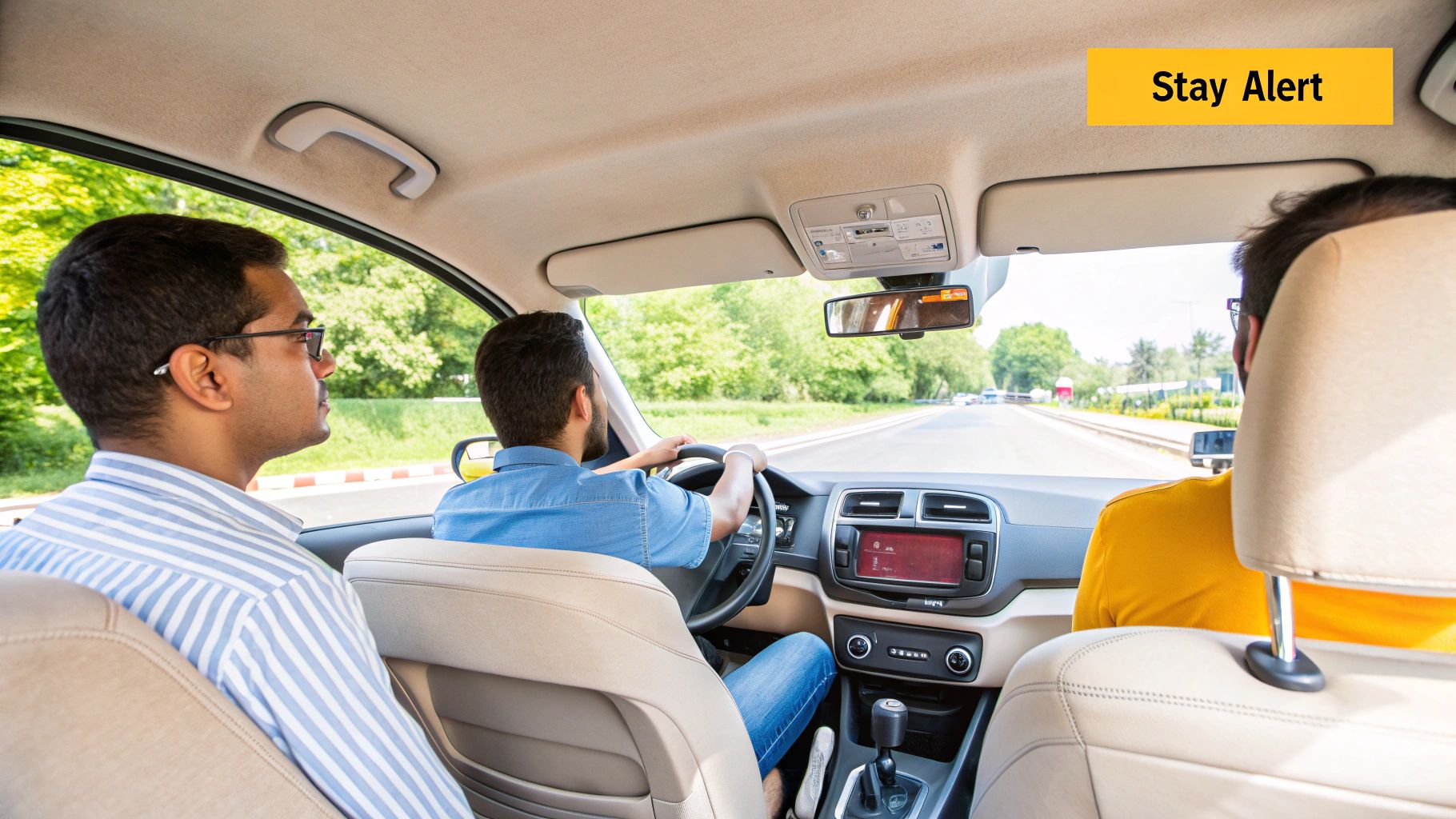
This principle is rigorously applied in professional transportation industries where the stakes are high. The Federal Motor Carrier Safety Administration enforces strict Hours of Service rules for truck drivers, and aviation authorities set firm duty time limits for pilots. These regulations exist because data proves that structured rest is non-negotiable for safety. According to the National Sleep Foundation, driving after being awake for 18 hours is equivalent to driving with a blood alcohol concentration (BAC) of 0.05%.
Your Essential Fatigue Management Plan
To effectively combat fatigue, you need a structured plan, not just a reliance on willpower or caffeine. This strategy ensures you remain sharp and responsive for the entire trip.
- Prioritize Pre-Trip Rest: The foundation of safe driving is a good night’s sleep. Ensure you get 7-8 hours of quality sleep for at least two consecutive nights before your departure to build up your energy reserves.
- Schedule Regular Breaks: Plan to stop every two hours or every 100 miles. Get out of the car, stretch, and take a short 15-20 minute break to reset your focus. This is one of the most effective road trip safety tips for preventing mental exhaustion.
- Share the Driving: If you have a co-driver, switch roles every 2-4 hours. This allows each person to rest, fully disengage from the task of driving, and recover their alertness.
- Avoid High-Risk Driving Times: Be aware of your body’s natural circadian rhythms. The most common periods for drowsiness are between 2-4 AM and 1-3 PM. Plan your driving schedule around these lulls whenever possible.
- Recognise the Warning Signs: Pay attention to symptoms like frequent yawning, heavy eyelids, difficulty focusing, or drifting from your lane. If you notice these, pull over immediately in a safe location and rest.
To further prevent driver fatigue and maintain optimal alertness throughout your journey, explore more proven fatigue management strategies that can complement these foundational practices. Managing your energy is just as important as managing your fuel tank; running on empty in either case can lead to a disastrous outcome.
5. Weather Monitoring and Adaptation
One of the most dynamic and unpredictable variables on any road trip is the weather. Proactive weather monitoring and adaptation involve more than just a quick glance at the forecast before you leave; it is a continuous process of assessing conditions along your entire route and being prepared to alter your plans, driving style, and even your vehicle’s setup to handle whatever nature throws at you. This is a critical safety pillar, transforming a potential crisis into a manageable inconvenience.
State highway departments and national weather services constantly emphasise this principle. For example, mountain pass closure systems in states like Colorado or California are designed to prevent drivers from getting stranded in sudden blizzards. Similarly, the rapid weather changes common in places like the North Atlantic coast require constant vigilance. For travellers planning a self-drive tour, understanding how to adapt to sudden rain or fog is a non-negotiable skill. You can explore how to prepare for such conditions on the varied landscapes of Ireland with B-Tours.com’s insightful guides on driving in Ireland.
Your Essential Weather Adaptation Plan
A smart traveler doesn’t just hope for good weather; they plan for bad weather. This strategic approach ensures you remain in control, regardless of the forecast.
- Plan for the Entire Route: Before you depart, check the detailed forecast for your entire path, not just your final destination. Use apps like The Weather Channel or AccuWeather to look at hourly forecasts for key points along your journey.
- Adapt Your Driving: The single most important adaptation is to reduce your speed and increase your following distance in adverse conditions like rain, snow, or fog. This gives you more time to react to hazards. Never use cruise control on wet or icy roads.
- Know When to Stop: There is no shame in pulling over. If visibility drops significantly due to heavy rain, fog, or a snow squall, find a safe place like a rest stop or a well-lit parking lot to wait for conditions to improve. Pushing through is a dangerous gamble.
- Carry a Season-Appropriate Kit: For winter travel, this means packing tire chains (and knowing how to install them), an ice scraper, and extra blankets. For summer trips through hot climates, carry extra water for both passengers and the vehicle’s radiator to prevent overheating.
This constant vigilance is one of the most vital road trip safety tips you can practice. It acknowledges that you are a guest in a dynamic environment and empowers you to make intelligent decisions that prioritise safety over a rigid schedule.
6. Communication and Check-in Protocols
While modern technology keeps us connected, establishing a formal communication and check-in plan is a critical safety net that ensures someone always knows your whereabouts. This goes beyond a casual text message; it’s a structured agreement with a trusted contact back home about when and how you will provide updates. This protocol is a fundamental practice for pilots, hikers, and search and rescue teams for a reason: it provides an early warning system if you deviate from your plan or encounter trouble, especially in areas with unreliable cell service.
This systematic approach is your personal safety dispatch. Just as commercial trucking companies use satellite tracking and law enforcement officers perform regular radio check-ins, your protocol ensures that a missed update triggers a predefined response. For any long-distance travel, especially through remote or unfamiliar territory, this is one of the most vital road trip safety tips to implement. It transforms wishful thinking into a concrete action plan, providing peace of mind for both you and your loved ones.
How to Build Your Communication Plan
A strong protocol is simple, clear, and agreed upon by all parties. Consistency is more important than complexity.
- Set a Realistic Schedule: Define specific check-in times. For example, agree to send a text every morning before you depart and another every evening upon arrival at your lodging. Be realistic; don’t set a schedule you can’t keep, which could cause unnecessary alarm.
- Share Your Detailed Itinerary: Your contact should have a copy of your full itinerary, including hotel addresses, confirmation numbers, and planned routes. Also include potential alternate routes you might take if faced with road closures.
- Define “No-Contact” Procedures: The most crucial step is deciding what happens if you miss a check-in. Establish a clear timeline for action. For example: “If you don’t hear from me by 10 PM, wait one hour, then try calling my cell and the hotel. If there is still no contact by midnight, initiate the emergency plan.”
- Use Multiple Communication Methods: Don’t rely solely on phone calls. Agree to use a combination of texts, social media updates (like a private Instagram story), or a family safety app like Life360. This provides redundancy if one method fails. For extreme remote travel, consider renting or buying a personal locator beacon (PLB) or satellite messenger.
This isn’t about being helicoptered; it’s about being prepared. A missed check-in might just be due to a dead phone battery or a “no service” zone, but a clear escalation plan ensures a measured response. It empowers your emergency contact to act effectively, transforming them from a worried bystander into an informed first line of defense if a real emergency occurs.
7. Defensive Driving Techniques
Mastering defensive driving is less about reacting to hazards and more about proactively anticipating and avoiding them before they materialize. This mindset shifts you from a passive participant to an active manager of your immediate environment, a critical skill for navigating unfamiliar roads and unpredictable traffic on a long journey. It’s a strategy employed by professional drivers, from emergency responders to logistics experts, who understand that preventing a dangerous situation is always superior to reacting to one.
The principles of defensive driving, popularised by institutions like the National Safety Council, are based on maintaining a “space cushion” around your vehicle and developing heightened situational awareness. This approach is invaluable during a road trip, where prolonged hours behind the wheel can lead to complacency. Adopting these techniques is one of the most impactful road trip safety tips because it directly reduces your risk of being involved in a collision caused by another driver’s error or adverse road conditions.
Your Essential Defensive Driving Checklist
Integrating these habits into your driving style will transform your ability to stay safe on the road. To further hone your on-road skills, exploring fundamental principles of safe driving can be highly beneficial, and these defensive driving techniques provide a strong foundation.
- Maintain a Safe Following Distance: The “three-second rule” is your baseline. In good weather, watch the vehicle ahead of you pass a fixed object (like a signpost) and count “one-thousand-one, one-thousand-two, one-thousand-three.” If you reach the object before finishing, you are too close. Increase this to five or six seconds in poor weather or when towing.
- Scan Ahead and Check Mirrors: Look 12 to 15 seconds down the road, not just at the car in front of you. This allows you to spot potential issues like stopped traffic, pedestrians, or road debris with ample time to react. Complement this by checking your rearview and side mirrors every 5-8 seconds to remain aware of your complete surroundings.
- Create an Escape Route: Always position your vehicle in a way that gives you an “out.” Avoid driving directly next to other cars for extended periods (their blind spot). By maintaining open space on at least one side, you give yourself a path to manoeuvre if another driver makes a sudden, unsafe move.
- Handle Aggressive Drivers with Care: If you encounter a driver who is tailgating, speeding, or weaving, the safest response is to remove yourself from their vicinity. Do not engage or retaliate. Slow down slightly (without braking abruptly) to encourage them to pass, or change lanes when it is safe to do so.
These practices are especially important when navigating the varied road networks you might encounter, such as on a self-drive tour in the UK. Discover how to apply these skills on a journey through historic landscapes by exploring our driving tours in England.
8. Vehicle Security and Anti-theft Measures
A road trip vehicle loaded with luggage, electronics, and personal items can be an attractive target for opportunistic criminals. Implementing robust vehicle security and anti-theft measures is a critical component of personal safety, ensuring your journey isn’t disrupted by the stress and loss associated with a break-in or theft. This goes beyond simply locking your doors; it involves a conscious strategy to make your vehicle an unappealing and difficult target.
Law enforcement agencies and organisations like the National Crime Prevention Council consistently emphasise that most vehicle-related thefts are crimes of opportunity. A visible laptop bag, a GPS unit left on the dash, or a vehicle parked in a dark, isolated corner all increase risk. By adopting a security-first mindset at every stop, from a quick lunch break to an overnight hotel stay, you proactively manage one of the most common threats travellers face. This is one of the most essential road trip safety tips because it protects not just your property, but also your peace of mind.
Your Essential Security Checklist
Integrating these practices into your routine will significantly harden your vehicle as a target and protect your valuables.
- Make Your Car Look Empty: This is the golden rule. Never leave any valuables visible inside your car, not even for a few minutes. Store luggage, shopping bags, electronics, and even loose change in the trunk or a covered cargo area before you arrive at your destination. A car that appears empty is far less likely to be targeted.
- Park Smart: Location is everything. Always choose well-lit, high-traffic areas to park, especially overnight. At hotels, park as close to the main entrance as possible or under a security camera. Avoid isolated spots at the back of parking lots or on dimly lit side streets.
- Add Visible Deterrents: Thieves look for easy targets. A physical steering wheel lock or a blinking LED from a car alarm system can be enough to make them move on to an easier vehicle. These visual cues signal that breaking in will be more difficult and time-consuming.
- Secure Your Keys and Valuables: When you leave the vehicle, your most important items should go with you. Always take your car keys, wallet, phone, and any essential documents like passports. Never hide a spare key on the vehicle itself; criminals know all the common hiding spots.
- Trust Your Gut: If a parking area or neighbourhood feels unsafe or gives you a bad feeling, trust your instincts. Find another place to park, even if it means walking a little further. Your intuition is a powerful safety tool.
For a deeper dive into preventing vehicle theft, the National Highway Traffic Safety Administration (NHTSA) offers detailed guidance and statistics.
By making these security measures a non-negotiable part of your road trip routine, you drastically reduce your vulnerability to theft. A secure vehicle allows you to fully immerse yourself in your adventure, confident that both you and your belongings are protected.
Road Trip Safety Tips: 8-Point Comparison
| Item | Implementation Complexity 🔄 | Resource Requirements ⚡ | Expected Outcomes 📊 | Ideal Use Cases 💡 | Key Advantages ⭐ |
|---|---|---|---|---|---|
| Pre-Trip Vehicle Inspection | Moderate – requires time and skills | Moderate – tools and possible mechanics | High – reduces breakdowns and accidents | Long trips, commercial transport, safety-critical | Prevents breakdowns, safety assurance |
| Emergency Kit Preparation | Low – assembling kit and maintenance | Low to Moderate – equipment and supplies | Medium – improves self-sufficiency in emergencies | All trips, especially remote or long-distance | Enables quick emergency response, safety boost |
| Route Planning and Navigation Backup | High–prep time and tech setup | Moderate – navigation devices/software | High – reduces travel time and stress | Complex routes, remote areas, time-sensitive trips | Alternative routes, hazard avoidance |
| Driver Fatigue Management | Moderate – scheduling and monitoring | Low – mainly time and rest plans | Very High – reduces accidents related to fatigue | Long drives, multi-driver trips | Reduces accidents, maintains alertness |
| Weather Monitoring and Adaptation | Moderate – continuous monitoring and adjustments | Low to Moderate – weather tools and supplies | High – prevents weather-related incidents | Areas with variable or severe weather | Proactive safety, trip flexibility |
| Communication and Check-in Protocols | Low to Moderate – setting schedules and tech use | Low – devices and apps | Medium – enables emergency response and location tracking | Remote travel, solo trips, and family communication | Peace of mind, rapid assistance |
| Defensive Driving Techniques | Moderate – training and constant focus | Low – mostly knowledge and awareness | Very High – significantly lowers accident risk | All driving, especially in high traffic or hazardous conditions | Accident prevention, fuel savings |
| Vehicle Security and Anti-theft Measures | Low to Moderate – installing and following protocols | Low to Moderate – security devices and vigilance | Medium – reduces theft and vandalism risk | Areas with higher crime rates, overnight stops | Protects vehicle and belongings |
Putting It All Together for Your Next Adventure
The open road promises unparalleled freedom, a direct line to the heart of discovery where every turn reveals a new vista, a hidden historical gem, or a charming village. Yet, the true art of a successful road trip is not found merely in the spontaneity of the journey, but in the diligent preparation that makes that spontaneity possible. We have navigated through a comprehensive checklist of critical road trip safety tips, moving beyond the obvious to provide a robust framework for a secure and memorable adventure. Your journey from a hopeful traveller to a confident road warrior begins by internalising these principles.
Think of these safety pillars not as restrictions, but as enablers. They are the invisible scaffolding that supports the entire structure of your trip, allowing you to focus on the experience itself, whether that’s tracing the footsteps of ancient Romans across Britain or chasing the Northern Lights along a remote Scottish byway. By shifting your mindset from reactive problem-solving to proactive readiness, you transform potential travel anxieties into quiet confidence.
Recapping Your Safety Toolkit
Let’s distil the core strategies we’ve discussed into a final, actionable summary. These are the cornerstones of a well-executed self-drive tour:
- Vehicle Readiness: Your car is more than just transport; it’s your partner on this adventure. A thorough pre-trip inspection of tires, fluids, brakes, and lights is non-negotiable. This simple act prevents the most common and disruptive roadside issues.
- Emergency Preparedness: Hope for the best, but prepare for the worst. Your emergency kit is your lifeline, equipped not just with first-aid supplies but with practical tools, food, water, and a power bank. It’s your self-sufficient backup plan.
- Strategic Navigation: Never rely on a single source. Combining a primary GPS with offline maps and a physical atlas ensures you are never truly lost, even when technology fails in remote areas. This is about building redundancy into your route.
- Vigilance Behind the Wheel: Mastering defensive driving and managing fatigue are active, not passive, skills. This means staying alert, creating space, avoiding distractions, and recognising your own physical limits by taking scheduled breaks. Your well-being is the most critical component of the journey.
From Knowledge to Action: Your Next Steps
Reading these tips is the first step, but integrating them is what truly matters. Before your next trip, transform this knowledge into a personalised pre-departure ritual.
- Create a Physical Checklist: Based on our guide, develop a tangible checklist for your specific trip. Include items for your vehicle inspection, your emergency kit contents, and your route-planning process.
- Schedule a “Dry Run”: A week before you leave, pack your emergency kit and place it in your vehicle. Test your navigation apps and download offline maps for your intended route. This simple exercise can reveal gaps in your preparation when you still have time to address them.
- Brief Your Passengers: Safety is a team sport. Walk through your communication plan and emergency protocols with everyone in your travel party. Ensure they know where the emergency kit is and how to use key items.
The ultimate goal of mastering these road trip safety tips is to empower your exploration. It’s about ensuring that your travel stories are filled with tales of breathtaking landscapes and cultural immersion, not accounts of preventable mishaps. By investing this time and effort upfront, you are safeguarding your journey and maximising your ability to connect with the destinations you’ve dreamed of visiting. You are not just planning a drive; you are engineering a seamless, safe, and deeply rewarding experience. Now, you are truly ready to hit the road.
Ready to embark on an expertly planned adventure without the stress of managing every detail yourself? BTOURS specialises in crafting self-drive tours that blend independent exploration with the security of a meticulously planned itinerary, including pre-vetted routes and accommodations. Explore our curated journeys at BTOURS and discover how we build safety and discovery into every mile.


